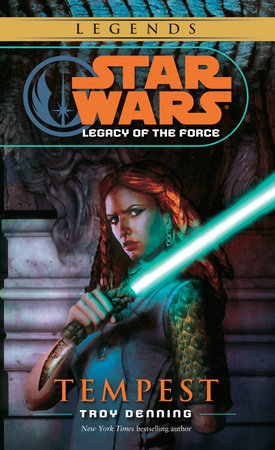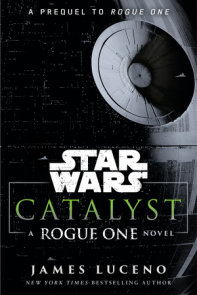Author Q&A
Interview with Jim Luceno, author of Star Wars The New Jedi Order: The Unifying Force:
Question:The Unifying Force is your third New Jedi Order novel, after the Agents of Chaos duology, Hero’s Trial and Jedi Eclipse. But your involvement with the series goes back to the beginning, both as a writer and behind the scenes. Can you tell us a little bit about how you became involved and what your contribution has been?
James Luceno:My involvement—initially as a kind of consultant—comes from my having overseen and co-written the Robotech series, which was also a multi-book sf saga. For the New Jedi Order I attended most of the writers meetings at Skywalker Ranch, helped draft and refine both the original outline and the series bible, read and commented on individual manuscripts, and, with Dan Wallace, expanded the Star Wars galaxy map. Editor Shelly Shapiro and I conferred throughout the series, and, when we´d reached the halfway mark, reassessed what we had done, pondered what still needed doing, and scratched our heads over how things should wrap up.
Q:The New Jedi Order comprises nineteen novels in an intricately linked storyline related by a dozen different writers. What are your feelings upon bringing this immense undertaking to a close after so many years?
JL:In a word: relief. At the start of the project, it seemed we had all the time in the world to see the story through. But Murphy´s Law quickly asserted itself, and before we knew it we were playing catch-up. Often three writers would be working on books simultaneously, and revision due dates were often in conflict with those of the authors’ non-Star Wars novels. For all their devotion to the series, Shelly and Sue Rostoni (at Lucasfilm) were frequently forced to turn their editorial talents to other projects. On top of that, there were canceled books, last-minute alterations to the story arc, illnesses, and all sorts of other obstacles to surmount.
Q:What were some of the low points for you personally in working on this project? The high points?
JL:From the start, the NJO drew a sizable readership, even in the face of competition from the prequel novels, the comics, and other Star Wars related series—and despite being handicapped by the fact that the core characters had already been taken through so many twists and turns. So there’s some sense of accomplishment in having been able to hold the interest of so many readers. It was also gratifying to see Troy Denning, Greg Keyes, Matt Stover, and others receive much-deserved acclaim for their individual efforts. An obvious low point might be fan reaction to Chewbacca´s death, but I expected no less. It was more depressing to see failures in character and plot-line continuity creep into the series. On a personal note, conflicting fan reaction to my books kept me from knowing just what I was doing right, or wrong.
Q:Your books being Hero’s Trial and Jedi Eclipse, the fourth and fifth books of the series; now you’ve written the final volume. Did you know you would be writing this book when you were working on the first two? How much of the over-arching series plot was known to writers in advance, and how much were you able to make up as you went along?
JL:I didn´t know in advance that I´d be writing the final book. But because I had been with the series since its inception, and had the advantage of having been privy to just about every idea that had been tossed around, I emerged as the sort of default choice. But copying every writer on every piece of email would probably have resulted in total confusion and too many points of view regarding plot points. The overarching story arc was known to everyone involved, but all of us had plenty of space to maneuver, in terms of secondary plots and character development. This turned out to be both a blessing and a bane. The specifics of the somewhat-revised story arc were known to only a few writers, and we were still making discoveries even after I had delivered a first draft of The Unifying Force. At one point, I recall having a list three pages long of plot threads that needed closing!
Q:One of the central themes of the series has been to investigate and resolve inconsistencies, one might even say paradoxes, in the way the Force has been presented or understood in previous novels and in the movies. For example, there is the mystery of the Yuuzhan Vong’s immunity to the Force, as well as disagreements between the Jedi about the nature of the dark side. Given all this, how much should fans read into the title, The Unifying Force?
JL:The title is meant to operate on several levels, and I remember my excitement on learning that Lucasfilm had approved its use. In the prequels, the unifying Force is defined as being more future-oriented and concerned with the consequences of actions—even seemingly right actions. The living force has more to do with being mindful of the present. The title plays to that distinction. At the same time, what remains of the New Republic is amassing a unified force of fleets to hurl against the Yuuzhan Vong. And by extension, the title could also refer to the so-called Shamed Ones, outcast Yuuzhan Vong who become pivotal in the end stages of the long war.
Q:Another theme has been the natural process of life: birth, maturation, death. We’ve seen the deaths of Chewie and Anakin; we’ve seen the birth of Luke and Mara’s son, Ben; we’ve seen the maturation of Jaina and, especially, Jacen, whose link to the Force seems to grow beyond even Luke’s. At the same time, on a larger scale, the same processes have unfolded in personal relationships, in political systems, in the clash of races and of civilizations. The same thing, like a universal law, seems to be operating on all these different levels; is it the Force?
JL:I feel on safer ground saying that it is different authors writing about the Force. Many an NJO plot point grew from the series outline itself; things were discovered along the way, as a kind of epiphenomenon of the creative process. As depicted in the films, the Force appears to operate in a similar fashion. I guess you could say that we were at least attempting to ally ourselves with the Force—to write in harmony with it.
Q:One of the many surprising revelations in the novel is that the Yuuzhan Vong were stripped of the Force: long ago, in a very real sense, they were exiled from it. This raises the question of whether the Force itself is sentient and willful, like a god. And if the Yuuzhan Vong could be stripped of the Force, why weren’t Darth Vader and the Sith similarly cast out when they began to misuse the Force?
JL:The introduction of midichlorians and the mystery surrounding Anakin Skywalker´s birth suggest that the Force can be willful when necessary—perhaps when those entrusted to maintain balance and to honor peace and justice have dropped the proverbial ball. Many would say that Nature operates this way, in fashioning ozone holes, igniting forest fires, or giving the earth a good shaking from time to time. The gross effect of sentient life is minimal when considered against the backdrop of the cosmic. The Force will do whatever’s necessary, regardless of what humans—or other sentients—have up their sleeves. It can be posited—and has—that the Sith and Darth Vader were essential to bringing the Force back into balance; that, in some fashion, they were very much linked to realizing the ultimate goal of the Force.
Q:Who is your favorite character in the novel, and why?
JL:I always enjoy writing Han Solo. But in The Unifying Force I found myself drawn to the characters who have found themselves caught in the middle and have been forced to rethink what they have long accepted as truths. On one side are Nom Anor and Harrar, and on the other, Jacen, Luke, and to some extent C-3PO.
Q:Your space battle scenes are fantastic. How do you write convincingly about something that is so far beyond current technology? Where do the tactics of space warfare come from? What were your models in crafting these scenes?
JL:I’m not accustomed to hearing my battle scenes described as "fantastic." One of the criticisms most often leveled against me is my inability to depict action. But maybe I’m improving. If I am, I attribute that to studying at the feet of the masters, who, in Star Wars, include Brian Daley, Tim Zahn, Mike Stackpole, Troy Denning, and Walter Jon Williams. As for models, I think that George Lucas supplied all of us with those in the opening sequence of A New Hope, and in the concluding scenes of Return of the Jedi, The Phantom Menace, and Attack of the Clones. Additionally, I grew up watching Victory at Sea on television, and with movies like Wings, Air Force, and other WW II epics.
Q:One thing that’s always disturbed me about the Star Wars universe is that the droids and other mechanicals, while obviously sentient, are slaves. I was hoping that their status might change in the course of the New Jedi Order; there were some hints of it early on, with the Vong’s harsh jihad against machine technology, but in the end, nothing changes. Characters like Luke and Leia, and most of the droids themselves, are strangely blind to this ongoing injustice. Is this something that future books will address? Why do you think it hasn’t been addressed before now?
JL:Sadly, that is one of the plot lines that got jettisoned along the way. I made a start on it in Hero’s Trial and Jedi Eclipse, but we soon realized that we had to concentrate on the main characters, Anakin chiefly, as a means of building to the events of Star by Star. More to the point, I think that the films themselves hint at a keen awareness on the part of droids, and suggest that living beings have a way of taking technology for granted. I suspect that both R2-D2 and C-3PO know far more than they ever reveal.
Q:After this long and difficult project, have you had your fill of Star Wars? Are you still a fan?
JL:I’ll always be a fan, but after the New Jedi Order wrapped, I thought I’d had my fill. That was until the folks at DK Publications asked if I’d be interested in writing the text for next year’s Classic Locations book!
Q:The Robotech novels you wrote with the late Brian Daley under the pen name Jack McKinney have many fans of their own. Are those books still available? Any chance of additions to the series?
JL:Several of the omnibuses were reprinted last year. I’m not certain they sold well enough to justify reprinting all twenty-one novels, but most of the titles are available at second-hand bookstores or through internet book sites. There’s always room for additional material. But I also I feel that Brian and I brought the characters to a kind of closure—even while suggesting that they’re still "out there," having adventures of the usual sort. Writers of long-running television series do the same thing, whether the series is MASH, Cheers, Buffy, or Friends. As a reader or a viewer, you want to know that everything turned out all right in the end; in a sense, that everyone is going to live happily ever after. And more important: that the peak experiences of their lives, the accounts of their principal quests, have been immortalized, and can be revisited at the turn of a page or the press of a button.
Q:Any upcoming novels you’d like to tell us about?
JL:Yes. But unfortunately, I’m not at liberty to say more!































